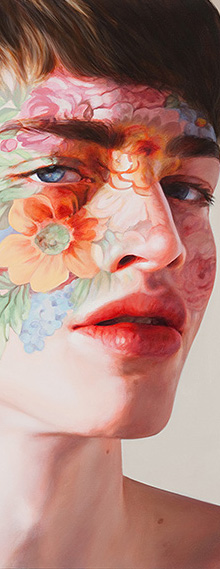
Tiberius (detail)
Oil on linen
2010
'While Time may bring the gifts of life, it is not life. Life is what you do with the gifts Time brings. ‘And with that the old woman was transformed into a swan as white as snow, and to this day you will not see a black swan and a white swan swimming together, for one is Time and the other is Life and they each have their own work.’
- The River Wife by Heather Rose
The swan is a symbol of transformative power. The classic fable of The Ugly Duckling, for example, describes the rites of passage to maturity, the shifts from perception of ugliness to perceptions of beauty. Yet these attributes themselves are culturally mediated.
Art takes the distinctive qualities of our culture and magnifies, examines, transforms them into something other. Deidre But-Husaim, aged 50 and mother of two teenage sons, has her artistic focus on youth and beauty, the changing manners of appearance. An early studio overlooked a tattoo parlour, and she watched the passing trade with its casual acquisition of permanent body markings on young and old. In Lonesome Doves (2009) she found her models through the posting of images and personal details of wannabe models on the internet, another public forum for display of personal identity and the immediacy of fashion. The resulting realist paintings of young faces and tattooed patterns capture the tension of the gaze that is simultaneously repulsed and fascinated.
The paintings in Swan Hunters were informed by But-Husaim’s travel to St Petersburg last year with her father in law, whose return to Belarus was his first since he fled the area as a young man during World War II. The baroque nature of the city, its decoration, art and antecedents made an overwhelming impression on But-Husaim and has drawn new influences into her work. Swan Hunter is a painted image of a sculpture she saw in the Hermitage, faithfully reproduced (including the ‘do not touch’ sign) but reset within patterns drawn from traditional Russian textile designs. Tiberius, the Roman Emperor, has a distinctly contemporary and youthful face overwritten by highly decorative patterning drawn from art in the Hermitage. But-Husaim is the swan hunter, trawling for contemporary models and historical imagery that may be merged into something other.
A trio of men, adorned by horns from slaughtered animals and elements from the rococo-gilded walls of the palace of Catherine the Great (or Ekaterina as she is called in Russian), suggests the ornate decadence of culture in the history of this ancient city. With But-Husaim’s comment, “No wonder there was a revolution”, ringing in my ears, it is possible to identify a similar mood – of vulnerabilities exposed, the Facebook/MySpace phenomena of living life in a public domain, the shrinking concept of personal space and privacy - which gestures toward an unfolding revolution of cultural mores. Beyond this is the need to look into the face of Tiberius, to read his tattooed smooth perfection. He holds our gaze - compelling, shocking, rejecting notions of beauty from earlier generations. He is not dependent on Time’s gifts.
© Louise Martin-Chew
***
Louise Martin-Chew is a freelance writer resident in Brisbane. She contributes to newspapers, national art magazines, catalogues and books. She is co-author (with artist Judy Watson) of blood language, published by Meigunyah Press (MUP) in 2009. She is also co-director with Alison Kubler of mc/k art, a consultancy with interests in public art, writing and publishing.
All rights reserved. No portion of this site may
be reproduced, copied or in any way reused
without permission of the author.